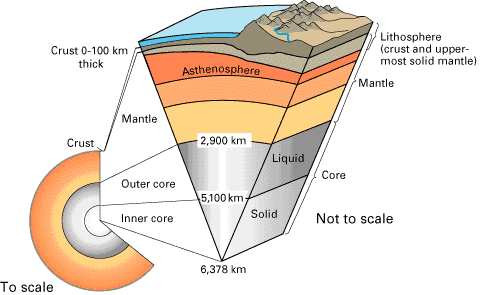
Inside the Earth
The size of the Earth -- about 12,750 kilometers (km) in diameter-was known
by the ancient Greeks, but it was not until the turn of the 20th century
that scientists determined that our planet is made up of three main layers:
crust, mantle, and core. This layered structure can be compared
to that of a boiled egg. The crust, the outermost layer, is rigid
and very thin compared with the other two. Beneath the oceans, the crust
varies little in thickness, generally extending only to about 5 km. The
thickness of the crust beneath continents is much more variable but averages
about 30 km; under large mountain ranges, such as the Alps or the Sierra
Nevada, however, the base of the crust can be as deep as 100 km. Like the
shell of an egg, the Earth's crust is brittle and can break.
Cutaway views showing the internal structure of the Earth. Below: This
view drawn to scale demonstrates that the Earth's crust literally is only
skin deep. Below right: A view not drawn to scale to show the Earth's three
main layers (crust, mantle, and core) in more detail (see text).

Below the crust is the mantle, a dense, hot layer of semi-solid rock
approximately 2,900 km thick. The mantle, which contains more iron, magnesium,
and calcium than the crust, is hotter and denser because temperature and
pressure inside the Earth increase with depth. As a comparison, the mantle
might be thought of as the white of a boiled egg. At the center of the Earth
lies the core, which is nearly twice as dense as the mantle because
its composition is metallic (iron-nickel alloy) rather than stony. Unlike
the yolk of an egg, however, the Earth's core is actually made up of two
distinct parts: a 2,200 km-thick liquid outer core and a 1,250 km-thick
solid inner core. As the Earth rotates, the liquid outer core spins,
creating the Earth's magnetic field.
Not surprisingly, the Earth's internal structure influences plate tectonics.
The upper part of the mantle is cooler and more rigid than the deep mantle;
in many ways, it behaves like the overlying crust. Together they form a
rigid layer of rock called the lithosphere (from lithos, Greek
for stone). The lithosphere tends to be thinnest under the oceans and in
volcanically active continental areas, such as the Western United States.
Averaging at least 80 km in thickness over much of the Earth, the lithosphere
has been broken up into the moving plates that contain the world's continents
and oceans. Scientists believe that below the lithosphere is a relatively
narrow, mobile zone in the mantle called the asthenosphere (from
asthenes, Greek for weak). This zone is composed of hot, semi-solid
material, which can soften and flow after being subjected to high temperature
and pressure over geologic time. The rigid lithosphere is thought to "float"
or move about on the slowly flowing asthenosphere.

